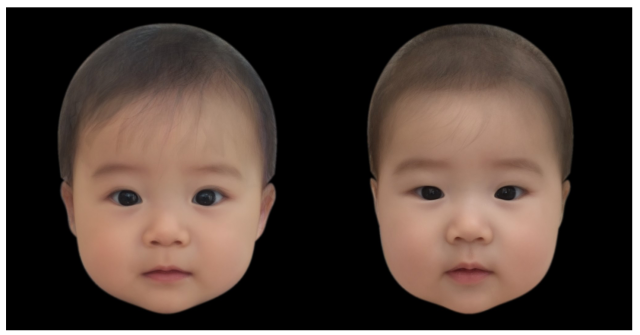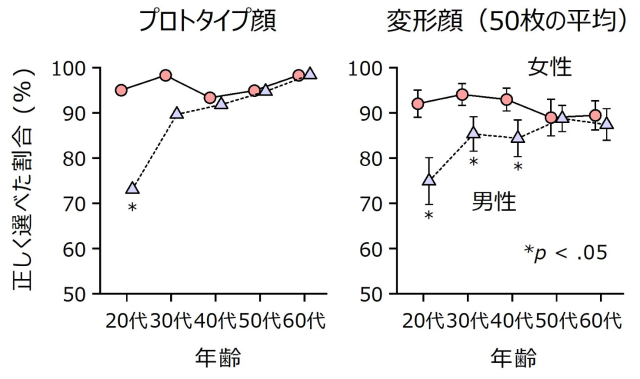
Your baby may be cute, but is it scientifically proven cute?
Cuteness is easily the most potent weapon in a baby’s arsenal. How else can they make adults succumb to their wills by repeatedly hand-feeding them and wiping their butts?
▼ “You there, cease that infernal clicking and clacking on your box and tend to my rear!”

Because of this, science has long sought for a way to end this reign of tyranny and attempted to decode the cuteness factors that make babies so powerful. In the 1940s, Austrian Nobel Laureate Konrad Lorenz made the breakthrough development of the kindchenschema or “baby schema” which is a set of facial features to trigger a sense of cuteness in humans. However, given Lorenz’s nationality, progress in kindchenschema was largely limited to Caucasian babies. So, a research group headed by Professor Hiroshi Nittono at the Graduate School of Human Sciences in Osaka University set out to determine the set of facial features that combine to make a cute Japanese baby.
Following the work pioneered by Lorenz, Nittono’s team gathered a collection of 80 expressionless frontal faces of six-month-olds and showed them to 200 Japanese men and women between the ages of 20 and 69. Those surveyed were asked to rate the babies on a scale of one to seven, with one being “not cute at all” and seven representing “very cute.” With the range of data collected, the researchers could look beyond matters of personal taste and isolate features that consistently lead to high cuteness scores. It turned out that these Japanese kindchenschema weren’t very different from Western ones after all.
In the next step in the study, the team used the factors to alter 50 baby faces, making both “cuter” and “less cute” versions.
▼ Top: Original baby, Bottom Left: Baby altered to look cuter, Bottom Right: Baby altered to look less cute
These pairs of faces were then shown to another 587 Japanese men and women via an online survey in which they were asked to select which one was cuter.
For the most part, respondents selected the scientifically cute baby 90 percent of the time. However, an interesting exception was the group of Japanese men in their 20s, who only chose the artificially cute baby 70 to 80 percent of the time. Either they’re of the enlightened mind that all babies are intrinsically equally cute, or they just can’t tell a cute baby if it puked rainbows in their faces.
▼ Graphs showing the results of the online surveys with percentages of matching answers on the y-axis and age group on the x-axis. Circles represent female respondents and triangles are males. The left graph shows the results from only the pair of faces pictured above. The right graphs shows the results of a further 50 pairs of faces.
The results of this study led to the creation of the Japanese Cute Infant Face (JCIF) Dataset which is freely available online for other to continue the research. I decided to download it myself and ran it through an enhanced AI that I developed in about five minutes to generate THE cutest human being ever to grace the Earth…

Perhaps humanity isn’t able to handle this level of cuteness yet.
As for overcoming the grip that babies have on our free will, more research will be needed. However, this data does open the door for creating an army of robots that can become artificially enchanted by newborns and do all the messy work for us. I hear Pepper’s looking for a new gig these days.
Source: ResOU, JCIF Dataset via MONOist
Images: ResOU unless otherwise noted
● Want to hear about SoraNews24’s latest articles as soon as they’re published? Follow us on Facebook and Twitter!



 Starbucks Japan ready to get Year of the Horse started with adorable drinkware and plushies【Pics】
Starbucks Japan ready to get Year of the Horse started with adorable drinkware and plushies【Pics】 Tiny house by Muji finally goes on sale in Japan
Tiny house by Muji finally goes on sale in Japan Japanese hotel has rooftop hot spring bath, unlimited sushi and alcohol, costs less than 80 bucks
Japanese hotel has rooftop hot spring bath, unlimited sushi and alcohol, costs less than 80 bucks Totoro sequel anime Mei and the Baby Catbus will screen at Ghibli Park this winter
Totoro sequel anime Mei and the Baby Catbus will screen at Ghibli Park this winter The old-school awesomeness of the New Akao, a Showa-era hot spring hotel still standing tall
The old-school awesomeness of the New Akao, a Showa-era hot spring hotel still standing tall Starbucks Japan ready to get Year of the Horse started with adorable drinkware and plushies【Pics】
Starbucks Japan ready to get Year of the Horse started with adorable drinkware and plushies【Pics】 Tiny house by Muji finally goes on sale in Japan
Tiny house by Muji finally goes on sale in Japan Japanese hotel has rooftop hot spring bath, unlimited sushi and alcohol, costs less than 80 bucks
Japanese hotel has rooftop hot spring bath, unlimited sushi and alcohol, costs less than 80 bucks Totoro sequel anime Mei and the Baby Catbus will screen at Ghibli Park this winter
Totoro sequel anime Mei and the Baby Catbus will screen at Ghibli Park this winter The old-school awesomeness of the New Akao, a Showa-era hot spring hotel still standing tall
The old-school awesomeness of the New Akao, a Showa-era hot spring hotel still standing tall The 10 best hotel hot springs in Japan, as chosen by Japanese travelers
The 10 best hotel hot springs in Japan, as chosen by Japanese travelers Special edition UNO allows you to play with Mario and co. in a whole new way
Special edition UNO allows you to play with Mario and co. in a whole new way Ultra-retro cafe in Tokyo is like a hidden hideout, serves up cheap breakfasts with great coffee
Ultra-retro cafe in Tokyo is like a hidden hideout, serves up cheap breakfasts with great coffee Summer nights at this amazing Tokyo open-air museum are like stepping back in time
Summer nights at this amazing Tokyo open-air museum are like stepping back in time We found possibly the quietest Japanese-style hotel in Tokyo’s bustling Shinjuku district
We found possibly the quietest Japanese-style hotel in Tokyo’s bustling Shinjuku district 7-Eleven Japan’s ramen-cooking robot whipped us up a bowl of noodles【Taste test】
7-Eleven Japan’s ramen-cooking robot whipped us up a bowl of noodles【Taste test】 Lacquerware supplier to emperor of Japan and Pokémon team up for new tableware
Lacquerware supplier to emperor of Japan and Pokémon team up for new tableware Cyberpunk anime meets traditional culture in Ghost in the Shell gold leaf Japanese changing screens
Cyberpunk anime meets traditional culture in Ghost in the Shell gold leaf Japanese changing screens 7 great places to see Mt. Fuji from without having to climb it
7 great places to see Mt. Fuji from without having to climb it Japan may add Japanese language proficiency, lifestyle classes to permanent foreign resident requirements
Japan may add Japanese language proficiency, lifestyle classes to permanent foreign resident requirements Hello Kitty Choco Egg figures are an adorable trip through three periods of Japanese pop culture【Pics】
Hello Kitty Choco Egg figures are an adorable trip through three periods of Japanese pop culture【Pics】 Japan’s otoshidama tradition of giving kids money at New Year’s gets a social welfare upgrade
Japan’s otoshidama tradition of giving kids money at New Year’s gets a social welfare upgrade Starbucks Japan releases new zodiac chilled cup drink for 2026
Starbucks Japan releases new zodiac chilled cup drink for 2026 Can a dirty butthole make you filthy rich in Japan? We’re starting a New Year’s lottery experiment
Can a dirty butthole make you filthy rich in Japan? We’re starting a New Year’s lottery experiment 7-Eleven Japan starts new temporary luggage storage service in over 300 branches
7-Eleven Japan starts new temporary luggage storage service in over 300 branches Disillusionment at Tsukiji’s tourist-target prices led us to a great ramen restaurant in Tokyo
Disillusionment at Tsukiji’s tourist-target prices led us to a great ramen restaurant in Tokyo Starbucks teams up with 166-year-old Kyoto doll maker for Year of the Horse decorations【Photos】
Starbucks teams up with 166-year-old Kyoto doll maker for Year of the Horse decorations【Photos】 Tokyo considering law requiring more trash cans following litter increase in heavily touristed area
Tokyo considering law requiring more trash cans following litter increase in heavily touristed area Tokyo’s Tsukiji sushi neighborhood asks tour groups to stay away for the rest of the month
Tokyo’s Tsukiji sushi neighborhood asks tour groups to stay away for the rest of the month Nintendo’s Kirby now delivering orders at Kura Sushi restaurants, but not in Japan
Nintendo’s Kirby now delivering orders at Kura Sushi restaurants, but not in Japan Tokyo event lets you travel back in time, for free, to celebrate 100 years since Showa era start
Tokyo event lets you travel back in time, for free, to celebrate 100 years since Showa era start Sanrio theme park in Japan announces plans to expand into a Sanrio resort
Sanrio theme park in Japan announces plans to expand into a Sanrio resort Stamina-destroying “Paralysis Noodles” are Tokyo’s newest over-the-top ramen innovation
Stamina-destroying “Paralysis Noodles” are Tokyo’s newest over-the-top ramen innovation Survey asks foreign tourists what bothered them in Japan, more than half gave same answer
Survey asks foreign tourists what bothered them in Japan, more than half gave same answer Japan’s human washing machines will go on sale to general public, demos to be held in Tokyo
Japan’s human washing machines will go on sale to general public, demos to be held in Tokyo Japan’s deadliest food claims more victims, but why do people keep eating it for New Year’s?
Japan’s deadliest food claims more victims, but why do people keep eating it for New Year’s? We deeply regret going into this tunnel on our walk in the mountains of Japan
We deeply regret going into this tunnel on our walk in the mountains of Japan Studio Ghibli releases Kodama forest spirits from Princess Mononoke to light up your home
Studio Ghibli releases Kodama forest spirits from Princess Mononoke to light up your home Major Japanese hotel chain says reservations via overseas booking sites may not be valid
Major Japanese hotel chain says reservations via overseas booking sites may not be valid Put sesame oil in your coffee? Japanese maker says it’s the best way to start your day【Taste test】
Put sesame oil in your coffee? Japanese maker says it’s the best way to start your day【Taste test】 No more using real katana for tourism activities, Japan’s National Police Agency says
No more using real katana for tourism activities, Japan’s National Police Agency says Starbucks Japan reveals new sakura drinkware collection, inspired by evening cherry blossoms
Starbucks Japan reveals new sakura drinkware collection, inspired by evening cherry blossoms Updated cherry blossom forecast shows extra-long sakura season for Japan this year
Updated cherry blossom forecast shows extra-long sakura season for Japan this year The 10 best hotel hot springs in Japan, as chosen by Japanese travelers
The 10 best hotel hot springs in Japan, as chosen by Japanese travelers Special edition UNO allows you to play with Mario and co. in a whole new way
Special edition UNO allows you to play with Mario and co. in a whole new way Ultra-retro cafe in Tokyo is like a hidden hideout, serves up cheap breakfasts with great coffee
Ultra-retro cafe in Tokyo is like a hidden hideout, serves up cheap breakfasts with great coffee Summer nights at this amazing Tokyo open-air museum are like stepping back in time
Summer nights at this amazing Tokyo open-air museum are like stepping back in time We found possibly the quietest Japanese-style hotel in Tokyo’s bustling Shinjuku district
We found possibly the quietest Japanese-style hotel in Tokyo’s bustling Shinjuku district The etiquette rules for visiting Shinto shrines in Japan
The etiquette rules for visiting Shinto shrines in Japan Eight Ways You Really, Really Shouldn’t Use a Japanese Toilet
Eight Ways You Really, Really Shouldn’t Use a Japanese Toilet Starbucks Japan releases new zodiac chilled cup drink for 2026
Starbucks Japan releases new zodiac chilled cup drink for 2026 More Than a Capsule Stay: Why Solo Travelers Choose “global cabin Yokohama Chinatown”
More Than a Capsule Stay: Why Solo Travelers Choose “global cabin Yokohama Chinatown” New retro museum in Tokyo is like a time portal back to the Showa era【Photos】
New retro museum in Tokyo is like a time portal back to the Showa era【Photos】 Massive manga mural takes over Tokyo station to celebrate Jujutsu Kaisen【Photos】
Massive manga mural takes over Tokyo station to celebrate Jujutsu Kaisen【Photos】 Visiting Evangelion’s Tokyo-3 anime locations in real-life Hakone【Photos】
Visiting Evangelion’s Tokyo-3 anime locations in real-life Hakone【Photos】 Amazon Japan makes payment policy change that could be a problem for foreigners in Japan
Amazon Japan makes payment policy change that could be a problem for foreigners in Japan
Leave a Reply